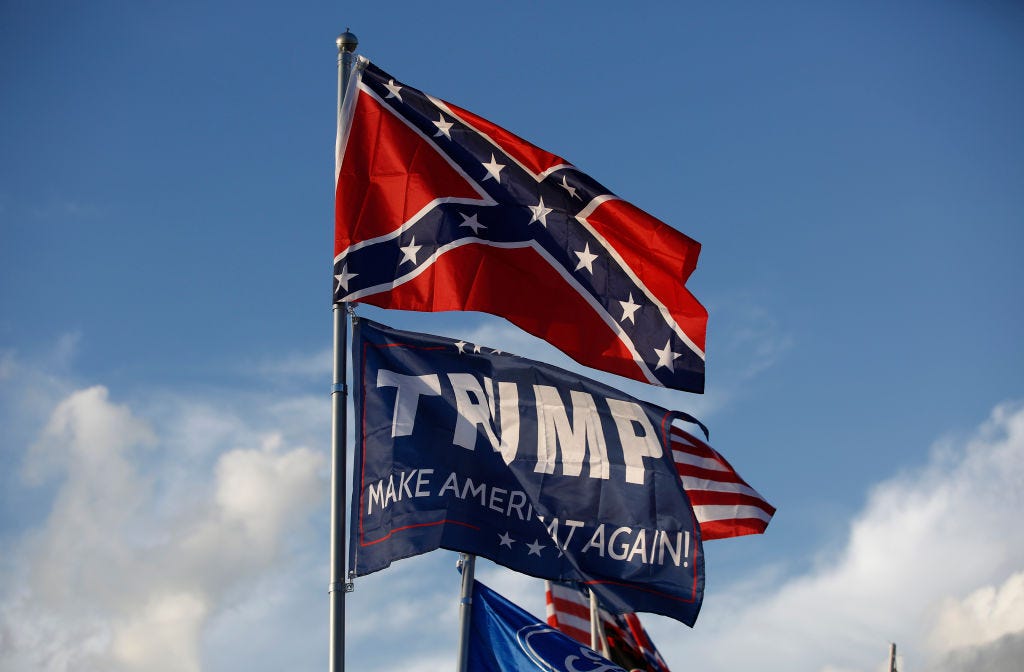Trump's Racist Campaign Is Rooted in the Confederacy
The Republican nominee echoes arguments underlying America’s original sin of slavery.

Viewed up close, Donald Trump’s crude, racist campaign seems out of place in 21st-century America 50 years after the triumphs of the civil rights movement.
But seen through a longer lens, it follows the eternal currents of our politics.
In demeaning, dehumanizing, and threatening non-white minorities, the Republican nominee echoes arguments underlying America’s original sin of slavery. In red states, he rouses the successors of those who built economic and social systems around the unchallenged dominance of white Christians who defied federal authority to impose changes.
The more diverse blue-state constituency of Vice President Kamala Harris, herself of mixed race, has long shown greater commitment to the nation’s egalitarian aspirations. The Civil War, the Great Depression, World War II, and the modernizing influences of globalization all failed to erase the fault line between competing political forces.
“It began with the Founding,” says long-time political analyst Michael Podhorzer, “and it’s the same divide.”
That divide, the former AFL-CIO political director tells me, represents more than mere variance between individual states. It pits “Blue America” against a separate “Red America” – “two countries with dramatically different value systems and standards of living.”
The result is divergent levels of commitment to the will of the majority and the rule of law. Red America’s nominees have lost the popular vote in seven of the last eight presidential elections, so Trump claims fraud and advocates restricting voting procedures. He challenges the legitimacy of federal prosecutors holding him accountable for election subversion.
Harris champions expanded access to the ballot. The former California attorney general vows to preserve the federal government’s tradition of Justice Department independence.
Red vs. Blue America
Red America traces back to the Confederacy, where enslaved labor made cotton and tobacco staples of the Southern economy. It has grown to encompass the rural Plains and Upper Midwest, with low-wage economies built on the extraction of natural resources and agriculture, as well as the most conservative portions of the Rust Belt.
Blue America is grounded in the Northeastern and free Western states that powered the Union’s Civil War triumph that ended slavery. These more urban states led the development of US industry and finance.
Podhorzer documents the disparate social outcomes the “Two Nations of America” have produced.
In the 17 more secular, urban states he defines as Blue America, residents receive more formal education and earn higher incomes. (Measured in a different way, counties that voted for President Joe Biden in 2020 accounted for 70% of US economic output.)
In the 27 states of Red America, residents attend church more frequently, have a greater incidence of poverty, and are less racially diverse. They have shorter life expectancy and higher rates of incarceration and firearm deaths.
The chasm separating their electoral preferences belies the common characterization of our politics. We are closely divided only in the aggregate and in the handful of battleground states where Harris and Trump will compete for three more weeks. Within Blue America and Red America themselves, races for the White House produce regional landslides that render the vast majority of states uncompetitive.
Education has become shorthand for defining each party’s base of support, with college graduates tilting Democratic and those without degrees leaning Republican. Yet region proves more powerful; in Blue America, Podhorzer notes, non-college whites vote for Democratic presidential candidates at higher rates than Red America’s college graduates.
State-level governance choices reflect their differences. Blue states implement background checks for gun sales, expand Medicaid under the Affordable Care Act, and double their red counterparts in spending on pre-kindergarten education.
Urged on by evangelical Christians, red states enact restrictions on abortion access. Since Barack Obama became our first Black president in 2009, nearly all have passed new voting restrictions. The ruling of a right-wing Supreme Court freed them from key constraints of the Voting Rights Act that, in 1965, ended their long struggle to deny Black people the ballot.
Trump’s racist attacks on Obama powered his emergence as the Republican Party’s leader. Analysis of returns in his 2016 victory showed his support correlated with racial resentment among white voters.
As a labor movement stalwart, Podhorzer cites different levels of unionization – higher in Blue America, lower in Red America with its right-to-work laws – as critical in entrenching the Red America-Blue America divide. But the overarching difference is in conceptions of the United States itself.
‘Criminally Anti-Democratic’
In the Civil War, the Union sought to vindicate its vision of a single nation, its federal government derived from popular sovereignty. The Confederacy rejected federal authority – and kept rejecting it even after losing the war.
Podhorzer considers Trump the leader of an analogous modern-day rebellion. The deadly Jan. 6 insurrection he incited defied the Constitution; if elected again, the former president suggests he will pardon “hostages” convicted of federal crimes from that violent day.
“The threat posed by Trump and the MAGA movement,” Podhorzer has written, “like the Confederate states, is not ‘conservative’ or even ‘extremist’ but criminally anti-democratic.”
Read previous editions of ‘The Stakes with John Harwood’ below:







White and Christian supremacy was established some 500 years ago, with the beginning of colonization of the New World, Africa, and Asia. Today's Trump voters are people who still cling to that same belief of supremacy; they may not even fully understand the history of it, but it is so engrained in their world view that it's almost an instinct. They may be living lives much like ours, but in their minds they are still on the wild frontier, keeping a shotgun close by, just in case.
America’s original sin casts a long shadow indeed. The Founding Fathers’ decision to compromise on the wording of the Declaration of Independence led to a century of slavery in the South. Andrew Johnson’s decision to compromise on “Reconstruction” led to another century of “Jim Crow”.
I wonder if Mr. Harwood believes that there’s a way to dig ourselves out of our current polarization through compromise. I no longer feel optimistic about that prospect but I also can’t think of a better solution.